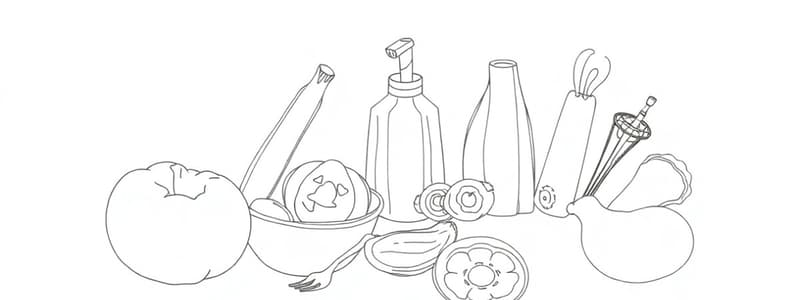Podcast
Questions and Answers
Questions are hidden until you start the quiz
Flashcards
Amino acids
Amino acids
Compounds in proteins used by the body to build and repair tissue.
Antioxidants
Antioxidants
Substances that protect the body from cell damage.
Anorexia nervosa
Anorexia nervosa
An eating disorder caused by an altered self-image.
Cholesterol
Cholesterol
Signup and view all the flashcards
MyPlate
MyPlate
Signup and view all the flashcards
Nutrients
Nutrients
Signup and view all the flashcards
Triglycerides
Triglycerides
Signup and view all the flashcards
Nutrition Facts on Labels
Nutrition Facts on Labels
Signup and view all the flashcards
Cariogenic Foods
Cariogenic Foods
Signup and view all the flashcards
Factors in Cariogenicity
Factors in Cariogenicity
Signup and view all the flashcards
Complex vs. Simple Carbohydrates
Complex vs. Simple Carbohydrates
Signup and view all the flashcards
Salivary Flow Benefits
Salivary Flow Benefits
Signup and view all the flashcards
Types of Carbohydrates
Types of Carbohydrates
Signup and view all the flashcards
Simple Carbohydrates
Simple Carbohydrates
Signup and view all the flashcards
Complex Carbohydrates
Complex Carbohydrates
Signup and view all the flashcards
Dietary Fiber
Dietary Fiber
Signup and view all the flashcards
Complete Proteins
Complete Proteins
Signup and view all the flashcards
Incomplete Proteins
Incomplete Proteins
Signup and view all the flashcards
Good vs. Bad Cholesterol
Good vs. Bad Cholesterol
Signup and view all the flashcards
Role of Water
Role of Water
Signup and view all the flashcards
Essential Minerals
Essential Minerals
Signup and view all the flashcards
Nutrition Facts Labels
Nutrition Facts Labels
Signup and view all the flashcards
Role of Saliva in Remineralization
Role of Saliva in Remineralization
Signup and view all the flashcards
Saliva Buffers
Saliva Buffers
Signup and view all the flashcards
Antibacterial Properties of Saliva
Antibacterial Properties of Saliva
Signup and view all the flashcards
Effects of Reduced Salivary Function
Effects of Reduced Salivary Function
Signup and view all the flashcards
Importance of Salivary Flow
Importance of Salivary Flow
Signup and view all the flashcards
CAMBRA
CAMBRA
Signup and view all the flashcards
Caries Risk Test
Caries Risk Test
Signup and view all the flashcards
Demineralization
Demineralization
Signup and view all the flashcards
Cavitated Lesion
Cavitated Lesion
Signup and view all the flashcards
Early Childhood Caries (ECC)
Early Childhood Caries (ECC)
Signup and view all the flashcards
Mutans Streptococci
Mutans Streptococci
Signup and view all the flashcards
Xerostomia
Xerostomia
Signup and view all the flashcards
Caries
Caries
Signup and view all the flashcards
Mutans streptococci (MS)
Mutans streptococci (MS)
Signup and view all the flashcards
Lactobacilli (LB)
Lactobacilli (LB)
Signup and view all the flashcards
Oral biofilm
Oral biofilm
Signup and view all the flashcards
Root caries
Root caries
Signup and view all the flashcards
Pit-and-fissure caries
Pit-and-fissure caries
Signup and view all the flashcards
Saliva
Saliva
Signup and view all the flashcards
Fermentable carbohydrates
Fermentable carbohydrates
Signup and view all the flashcards
Gingivitis
Gingivitis
Signup and view all the flashcards
Periodontitis
Periodontitis
Signup and view all the flashcards
Stages of Periodontitis
Stages of Periodontitis
Signup and view all the flashcards
Periodontal Pockets
Periodontal Pockets
Signup and view all the flashcards
American Academy of Periodontology (AAP)
American Academy of Periodontology (AAP)
Signup and view all the flashcards
Bacterial Impact on Periodontal Health
Bacterial Impact on Periodontal Health
Signup and view all the flashcards
Dental plaque
Dental plaque
Signup and view all the flashcards
Calculus (tartar)
Calculus (tartar)
Signup and view all the flashcards
Supragingival calculus
Supragingival calculus
Signup and view all the flashcards
Subgingival calculus
Subgingival calculus
Signup and view all the flashcards
Periodontal disease
Periodontal disease
Signup and view all the flashcards
Systemic diseases related to periodontal disease
Systemic diseases related to periodontal disease
Signup and view all the flashcards
Materia alba
Materia alba
Signup and view all the flashcards
Alveolar bone
Alveolar bone
Signup and view all the flashcards
Cementum
Cementum
Signup and view all the flashcards
Risk factors for periodontal disease
Risk factors for periodontal disease
Signup and view all the flashcards
Periodontium
Periodontium
Signup and view all the flashcards
Gingiva
Gingiva
Signup and view all the flashcards
Sulcus
Sulcus
Signup and view all the flashcards
Bacterial plaque
Bacterial plaque
Signup and view all the flashcards
Signs of periodontal disease
Signs of periodontal disease
Signup and view all the flashcards
Epithelial attachment
Epithelial attachment
Signup and view all the flashcards
Periodontal ligaments
Periodontal ligaments
Signup and view all the flashcards
Treatment for periodontal disease
Treatment for periodontal disease
Signup and view all the flashcards
Abscess
Abscess
Signup and view all the flashcards
Biopsy
Biopsy
Signup and view all the flashcards
Candidiasis
Candidiasis
Signup and view all the flashcards
Cellulitis
Cellulitis
Signup and view all the flashcards
Hemorrhage
Hemorrhage
Signup and view all the flashcards
Erosion
Erosion
Signup and view all the flashcards
Sarcoma
Sarcoma
Signup and view all the flashcards
Oral Pathology
Oral Pathology
Signup and view all the flashcards
Clinical Diagnosis
Clinical Diagnosis
Signup and view all the flashcards
Ulcer
Ulcer
Signup and view all the flashcards
Cyst
Cyst
Signup and view all the flashcards
Lesion
Lesion
Signup and view all the flashcards
Black hairy tongue
Black hairy tongue
Signup and view all the flashcards
Geographic tongue
Geographic tongue
Signup and view all the flashcards
Fissured tongue
Fissured tongue
Signup and view all the flashcards
Pernicious anemia
Pernicious anemia
Signup and view all the flashcards
Osteoradionecrosis
Osteoradionecrosis
Signup and view all the flashcards
Chemotherapy oral implications
Chemotherapy oral implications
Signup and view all the flashcards
Granuloma
Granuloma
Signup and view all the flashcards
Leukoplakia
Leukoplakia
Signup and view all the flashcards
Lichen Planus
Lichen Planus
Signup and view all the flashcards
Pseudomembranous Candidiasis
Pseudomembranous Candidiasis
Signup and view all the flashcards
Aphthous Ulcers
Aphthous Ulcers
Signup and view all the flashcards
Minor RAU
Minor RAU
Signup and view all the flashcards
Major RAU
Major RAU
Signup and view all the flashcards
Glossitis
Glossitis
Signup and view all the flashcards




